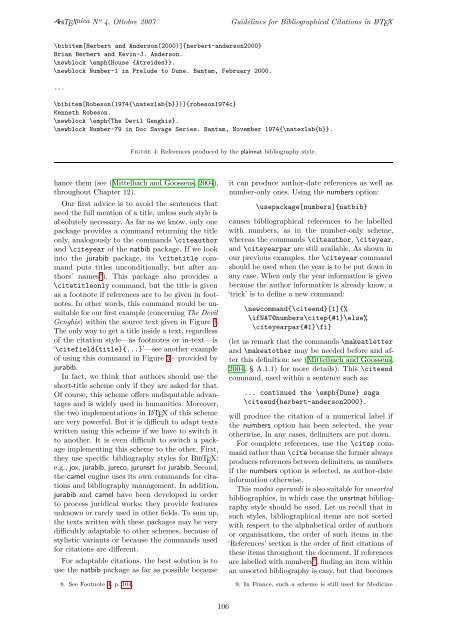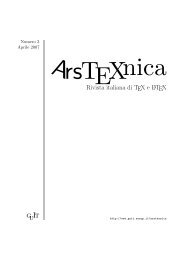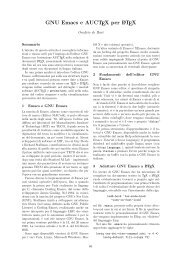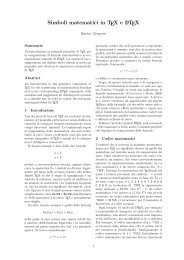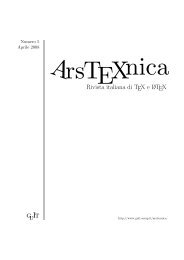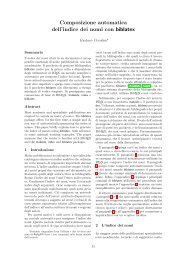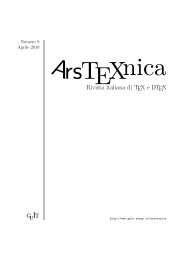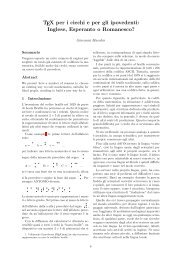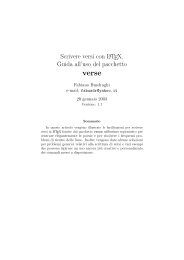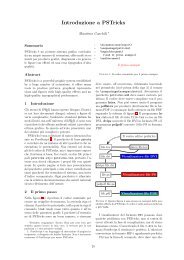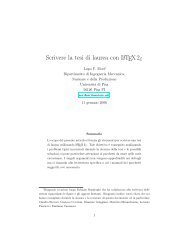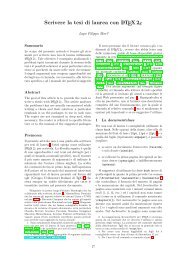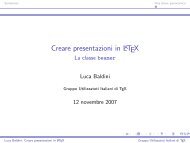ArsTeXnica, Numero 4, Ottobre 2007 - GuIT - Scuola Superiore Sant ...
ArsTeXnica, Numero 4, Ottobre 2007 - GuIT - Scuola Superiore Sant ...
ArsTeXnica, Numero 4, Ottobre 2007 - GuIT - Scuola Superiore Sant ...
You also want an ePaper? Increase the reach of your titles
YUMPU automatically turns print PDFs into web optimized ePapers that Google loves.
ArsT EXnica Nº 4, <strong>Ottobre</strong> <strong>2007</strong> Guidelines for Bibliographical Citations in LAT EX<br />
\bibitem[Herbert and Anderson(2000)]{herbert-anderson2000}<br />
Brian Herbert and Kevin~J. Anderson.<br />
\newblock \emph{House {Atreides}}.<br />
\newblock Number~1 in Prelude to Dune. Bantam, February 2000.<br />
...<br />
\bibitem[Robeson(1974{\natexlab{b}})]{robeson1974c}<br />
Kenneth Robeson.<br />
\newblock \emph{The Devil Genghis}.<br />
\newblock Number~79 in Doc Savage Series. Bantam, November 1974{\natexlab{b}}.<br />
Figure 4: References produced by the plainnat bibliography style.<br />
hance them (see (Mittelbach and Goossens, 2004),<br />
throughout Chapter 12).<br />
Our first advice is to avoid the sentences that<br />
need the full mention of a title, unless such style is<br />
absolutely necessary. As far as we know, only one<br />
package provides a command returning the title<br />
only, analogously to the commands \citeauthor<br />
and \citeyear of the natbib package. If we look<br />
into the jurabib package, its \citetitle command<br />
puts titles unconditionally, but after authors’<br />
names 8 ). This package also provides a<br />
\citetitleonly command, but the title is given<br />
as a footnote if references are to be given in footnotes.<br />
In other words, this command would be unsuitable<br />
for our first example (concerning The Devil<br />
Genghis) within the source text given in Figure 3.<br />
The only way to get a title inside a text, regardless<br />
of the citation style—as footnotes or in-text—is<br />
‘\citefield{title}{...}’—see another example<br />
of using this command in Figure 3—provided by<br />
jurabib.<br />
In fact, we think that authors should use the<br />
short-title scheme only if they are asked for that.<br />
Of course, this scheme offers undisputable advantages<br />
and is widely used in humanities. Moreover,<br />
the two implementations in L ATEX of this scheme<br />
are very powerful. But it is difficult to adapt texts<br />
written using this scheme if we have to switch it<br />
to another. It is even difficult to switch a package<br />
implementing this scheme to the other. First,<br />
they use specific bibliography styles for BibT E X:<br />
e.g., jox, jurabib, jureco, jurunsrt for jurabib. Second,<br />
the camel engine uses its own commands for citations<br />
and bibliography management. In addition,<br />
jurabib and camel have been developed in order<br />
to process juridical works: they provide features<br />
unknown or rarely used in other fields. To sum up,<br />
the texts written with these packages may be very<br />
difficultly adaptable to other schemes, because of<br />
stylistic variants or because the commands used<br />
for citations are different.<br />
For adaptable citations, the best solution is to<br />
use the natbib package as far as possible because<br />
8. See Footnote 4, p. 104.<br />
106<br />
it can produce author-date references as well as<br />
number-only ones. Using the numbers option:<br />
\usepackage[numbers]{natbib}<br />
causes bibliographical references to be labelled<br />
with numbers, as in the number-only scheme,<br />
whereas the commands \citeauthor, \citeyear,<br />
and \citeyearpar are still available. As shown in<br />
our previous examples, the \citeyear command<br />
should be used when the year is to be put down in<br />
any case. When only the year information is given<br />
because the author information is already know, a<br />
‘trick’ is to define a new command:<br />
\newcommand{\citeend}[1]{%<br />
\ifNAT@numbers\citep{#1}\else%<br />
\citeyearpar{#1}\fi}<br />
(let us remark that the commands \makeatletter<br />
and \makeatother may be needed before and after<br />
this definition: see (Mittelbach and Goossens,<br />
2004, § A.1.1) for more details). This \citeend<br />
command, used within a sentence such as:<br />
... continued the \emph{Dune} saga<br />
\citeend{herbert-anderson2000}.<br />
will produce the citation of a numerical label if<br />
the numbers option has been selected, the year<br />
otherwise. In any cases, delimiters are put down.<br />
For complete references, use the \citep command<br />
rather than \cite because the former always<br />
produces references between delimiters, as numbers<br />
if the numbers option is selected, as author-date<br />
information otherwise.<br />
This modus operandi is also suitable for unsorted<br />
bibliographies, in which case the unsrtnat bibliography<br />
style should be used. Let us recall that in<br />
such styles, bibliographical items are not sorted<br />
with respect to the alphabetical order of authors<br />
or organisations, the order of such items in the<br />
‘References’ section is the order of first citations of<br />
these items throughout the document. If references<br />
are labelled with numbers 9 , finding an item within<br />
an unsorted bibliography is easy, but that becomes<br />
9. In France, such a scheme is still used for Medicine


